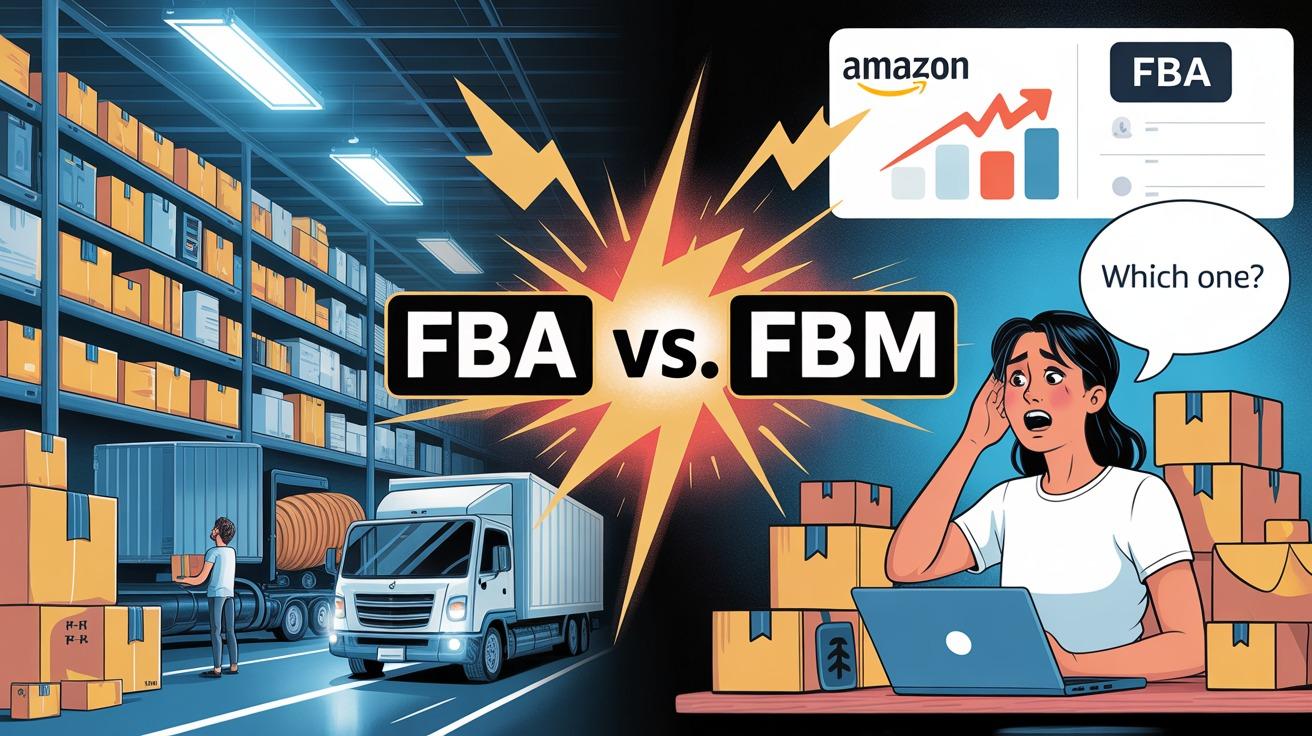Amazon FBA vs. FBM: Which Fulfillment Method Works Best for Optimizing Listings?

When you are selling on Amazon, perhaps one of the initial (and definitely most confusing) choices you will take is the following one: FBA or FBM?
Sure, it is a difficult choice. Fret not though, we are explaining everything to you.
And at the end of this guide, you will understand exactly which of the two fulfillment methods: FBA or FBM is most suitable to optimize your listings and stand a chance of a good search result position, getting the Buy Box, and customer satisfaction.
So without further ado, Let us get into it.
What does FBA and FBM mean?
Just to be clear, then, we are here on the same plane:
FBA (Fulfillment by Amazon): Your products get shipped to the warehouse of Amazon. Amazon does shipping, refunds and after sales service.
FBM (Fulfillment by Merchant): The inventory is left in your care and you (or a 3rd party) ship products out.
That is easy, isn t it? However the devil is in the details- wonders especially when we are talking about the listing optimization.
Why Listing Optimization Matters (More Than You Think)
Before we talk about which method is “better,” let’s get clear on this:
A well-optimized listing = more traffic, more sales, and better chances at that sweet Buy Box.
And guess what? The fulfillment method you choose can affect how well your listing performs on Amazon.
Now let’s get to the good part.
How FBA Helps Optimize Your Amazon Listing
Here’s the thing—Amazon loves FBA. Like really loves it.
1. Higher Chance of Winning the Buy Box
If you’re using FBA, Amazon handles your shipping and customer service. That means your delivery times are fast, and your customer metrics stay clean. And Amazon rewards you for that with better Buy Box visibility.
You could be selling the same thing as someone using FBM, but if you're FBA, boom—you get the Buy Box. More visibility = more sales.
2. Better Prime Eligibility
Let’s be honest: Shoppers trust Prime. It’s quick, it's free (kinda), and it feels safe.
FBA products automatically get that blue Prime badge.
And yep, that little badge makes a big difference when someone’s choosing between two sellers. It increases CTR (click-through rate) and conversion rate like crazy.
3. Better Seller Metrics (Without the Hassle)
FBA takes care of returns, shipping issues, and customer service. So you’re less likely to get hit with late shipment rates or customer complaints that mess with your account health.
Better seller metrics = better chance Amazon will promote your listings in search.
That’s why so many Amazon Seller Central Experts recommend FBA to scale fast.
Where FBM is Best (Yes, it also Has Advantages)
Okay, but what in case you are interested in more control? Or perhaps you sell something perishable, big, fragile?
FBM is not so bad after all. As a matter of fact, it is better in other instances.
1. Greater Inventory and Brand Management
You have some strong feelings about the packaging, the unboxing effect, or just want to add flyers or some marketing cards to it--FBM allows you to do that.
Since you are shipping direct, you can make things personal. That is gold to establish brand loyalty.
2. Reduced expenses (Occasionally)
The charges of FBA may be expensive. Especially when your product is left too long in the warehouse of theirs.
FBM will allow you to reduce expenses on storage, particularly in case you already possess a decent 3PL (third party logistics) arrangement.
In the event that you are in control of things, FBM can interpreted as more profit per sale.
3. Suitable in case of Unique or Low-Volume products
Have a special piece? Or you are just a beginner and cannot set even hundreds of units to Amazon?
FBM can be simpler (and less costly) to implement when you have a small catalogue, or when you are experimenting with new SKUs.
That is why the Amazon Seller Experts tend to use FBM initially and then move to FBA as soon as they define the demand.
So… Which One is Better for Listing Optimization?
Here’s the honest answer: It depends on your goals.
But let’s break it down based on the 3 key areas that affect listing optimization:
1. Visibility in Search
-
FBA wins. Because Amazon prefers fast shipping and great seller metrics, FBA listings tend to show up higher in search.
-
FBM sellers can rank too, but they usually need top-tier performance metrics.
2. Conversion Rate
-
FBA wins again. That Prime badge gives your listing instant credibility. Customers feel safer, and that drives up your conversions.
-
FBM can convert well too—especially if your pricing is better—but you'll need strong reviews and trust signals.
3. Customer Experience
-
FBA is king here. Amazon handles everything, and buyers love the consistency.
-
FBM is hit or miss. If you’re great at fulfillment, you can compete. But mess up one shipment, and your listing will suffer.
Real Talk: What Do Most Amazon Seller Experts Recommend?
Most Amazon Seller Account Management services (including the pros behind Channel Supply Experts) suggest this:
✅ Start with FBA if your product fits the mold (small, fast-moving, not fragile)
✅ Use FBM for bulky items, low-margin goods, or when testing new products
✅ Eventually, do both—Hybrid fulfillment gives you flexibility and control
That’s what the top Amazon Seller Central Experts are doing in 2025.
But Wait… Will Fulfillment Method Alone Optimize My Listing?
Nope. It’s one piece of the puzzle.
Even if you use FBA, your listing still needs:
-
Killer product titles with keywords
-
Clear bullet points that answer customer questions
-
High-quality images and videos
-
A+ content (or Enhanced Brand Content)
-
Regular performance tracking
And if you're stuck or confused, that’s exactly where Amazon Seller Experts come in handy. They’ll make sure you’re not leaving money on the table.
Final Thoughts: FBA vs FBM for Optimization
Let’s wrap it up with a quick cheat sheet:
|
Feature |
FBA |
FBM |
|
Prime Badge |
✅ |
❌ (unless SFP) |
|
Buy Box Priority |
✅ |
❌ |
|
Listing Rank Boost |
✅ |
❌ |
|
Cost Control |
❌ |
✅ |
|
Brand Packaging |
❌ |
✅ |
|
Seller Metric Risk |
✅ (lower) |
❌ (higher) |
So, yeah—FBA is usually better for optimizing listings, especially if you want to scale fast and rank higher.
But FBM still has its place. It’s not about one being right or wrong—it’s about what works best for you.
Got Questions?
Still confused between FBA and FBM? No worries. Fulfillment decisions are a big deal—and if you need help, reach out to an Amazon Seller Account Management expert who can walk you through the numbers and strategy.
Or just ask us below. We’re here to help.






